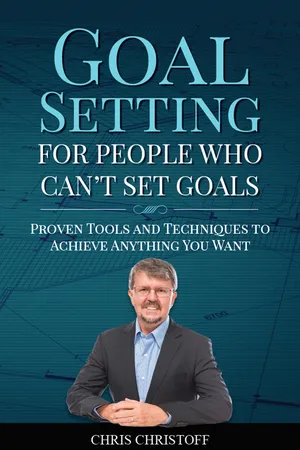![]()
![]()
CHAPTER 1
What is goal setting? You do it every day
“You are never too old to set another goal or to
dream a new dream.”
C. S. Lewis – British Novelist, Poet, Academic, 1898-1963
“Goal setting is not a mechanical process. It is training your subconscious to enjoy defining and achieving goals.”
Chris Christoff
“Make your goals addictive.”
Marc Miles – Australian Educator, Trainer, Speaker, Entrepreneur, 1979-
Let’s get something clear from the start. You are a goal setter and goal achiever!
Every day you set goals to get to work or school, to work through the day’s activities and meet your work or school deadlines. You set reminders to awake in the morning and for family and friends’ birthdays. You put wedding invitations on the fridge, along with pictures of your next holiday destination. You plan weekend adventures. You arrange other transport if your car is in for repairs or if there is a public transport breakdown. You ask others for help or advice.
You plan ahead, tackle the small goals, schedule timeframes, meet deadlines, put up reminders and display motivating images, overcome obstructions and seek mentorship. You do all of the little actions that navigate you to the bigger goals – each day, each year, life.
You are a goal setter!
Admittedly, some of those examples are more like tasks than goals but the principle is the same. You identify what you want or need, you plan a path to get it, you take the actions, engage others to help when needed and you reach the goal.
Goal achievement is the systematic performance of the required steps to reach a target, something you want. Goal setting is often taught as a “mechanical” process that takes discipline and willpower. I believe there needs to be flexibility, even tailoring the process to your personality, for everything from defining the goal to working out the path and setting the timeframe, to how you adjust for obstacles, setbacks and even failures. This philosophy drives the methods in this book.
In his book, “Psycho-Cybernetics,” first published in 1960 and modernized in 2001i, Maxwell Maltz, a cosmetic surgeon, tells how many of his patients suffered from poor self-esteem and through his practice he helped correct that, rather than use the surgeon’s knife. His book discusses the principles of modern goal setting and self-improvement, including visualization, affirmations and the workings of the subconscious as an automatic success mechanism. He likens our success instinct to a missile wandering off course, using this feedback to correct the error and reset the course back on track to the target. The missile drifts off-target, corrects and then drifts off again. The missile literally fails its way to the target. Maltz’s automatic success system is your subconscious and Reticular Activating System (RAS).
Reticular Activating System
The RAS is an intricate collection of neuron circuits connecting the brainstem (the movement and sensory part) to the cortex (the thinking part) of the brain. Primarily it controls wakefulness, attention and the sleep-wake transitions.
The RAS is a filter, controlling the information getting to your brain and hence, what you pay attention to. The RAS plays a part in your survival instincts by bringing to your attention anything threatening you. Your attention is quickly focused, for example, by loud noises, if you think you see a snake or when you hear your name spoken across a noisy room. Your fight-or-flight mechanism activates if there is danger, preparing your body to run or to fight. It fires off adrenaline, dopamine and serotonin to ready your muscles and your brain for fast action. It increases heart rate and blood flow, dilates pupils of the eyes to see better, and increases blood sugar level for the energy you may need for intense physical activity.
The RAS, able to process 100 million signals per second, has a pre-conscious awareness of the environment and feeds information to your conscious mind for decision and action. The RAS provides needed information based on what your conscious mind is doing. If you are looking for something, you provide a picture of it to your RAS and it helps to “notice” it. This is also why sometimes you can’t find it when it is in plain sight because you have the wrong picture (which results in conversations like this with my wife – “Chris, it is right there in front of you!” “No it’s not…oh, yes it is…I thought it was blue not red”).
The RAS is the “noticer,” picking up on the unusual or changes, things new or different, in the environment and signaling them as is necessary to the conscious. The RAS and associated brain systems are your autopilot. When you decide to do something, the RAS and the subconscious go to work guiding you to achieve it. Often it is without conscious thought, leaving you to think about something else. As simple examples, consider these – driving to work and not noticing how many red lights there were, or knitting a sweater while watching TV and carrying on a conversation. One key element here is, through practice, repetition and experience, those people are able to perform those activities with considerable skill and their subconscious guides them now. They trained their subconscious minds.
If someone points something out to you that you didn’t notice before, your RAS will notice those things in the environment. Have you experienced the situation where you bought a new car/clothing/jewelry and then noticed lots of other people with the same thing? After a while, you stop noticing as it is no longer novel. The RAS helps you seek out what you want and helps look for opportunities, and solutions to obstacles. Sounds perfect for goal achievement, if you program it, doesn’t it?
Performing the actions required to deliver the outcomes, assisted by the deliberate training of the subconscious, is the path to goal achievement. You train the subconscious through affirmations, visualizations (thinkualizations) and the feedback from performing the actions and succeeding or failing. Thinkualization is a big part and we will explore this deeply, as it is far more than just a picture in the mind.
Visionary people set goals
History is replete with pioneers, entrepreneurs, adventurers, athletes, activists and leaders who dared to believe in a possibility that had not previously existed – Albert Einstein, Christopher Columbus, Roger Bannister, Rosa Parks and Nelson Mandela, to name but a few. These people believed in a dream that did not exist before they set their sights on their goal. In a real way, they created their own reality and in so doing, changed the world forever.
What we believe is possible absolutely determines our reality. On May 6th 1954, Roger Bannister ran a mile in 3 minutes 59.4 seconds – the first time four minutes had been broken since accurate recordings started back in 1850. For 104 years, everyone thought that breaking this four minute milestone was outside the capabilities of the human body. It only took 46 days before someone else, John Landy, an Australian, broke Bannister’s record. By the end of 1957, 16 runners had broken the magic four minute mile. Why? The psychological barriers lifted due to evidence.
“Whether you believe yo...

